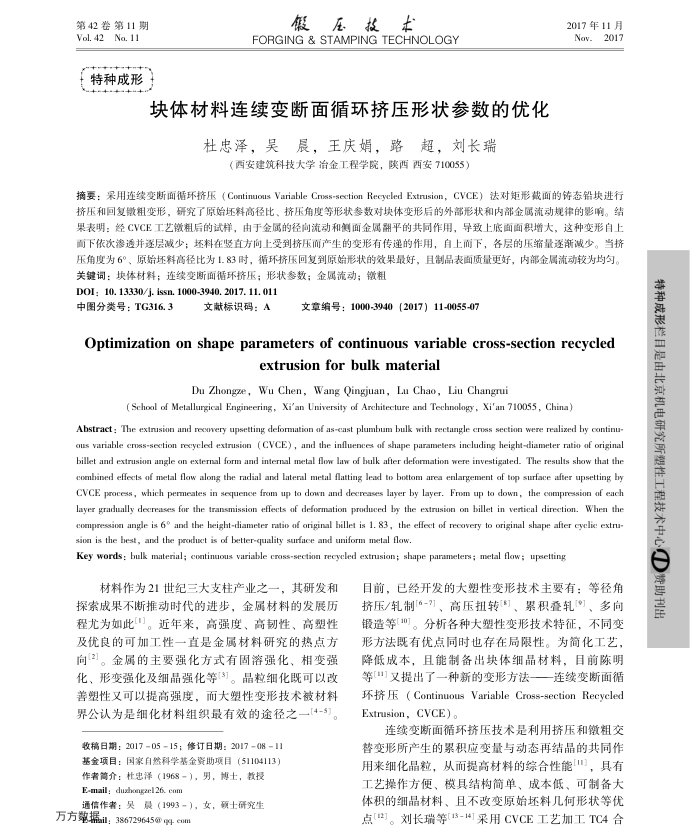您当前的位置:首页>论文资料>块体材料连续变断面循环挤压形状参数的优化
内容简介
 第42卷第11期 Vol. 42No. 11
第42卷第11期 Vol. 42No. 11特种成形
假压技木
FORGING & STAMPING TECHNOLOGY
块体材料莲续变断面循环挤压形状参数的优化
杜忠泽,吴晨,王庆娟,路超,刘长瑞
(西安建筑科技大学冶金工程学院,陕西西安710055)
2017年11月 Nov.2017
摘要:采用连续变断面循环挤压(ContinuousVariableCross-sectionRecyeled Extrusion,CVCE)法对矩形截面的铸态铅块进行挤压和回复租变形,研究了原始坏料高径比、挤压角度等形状参数对块体变形后的外部形状和内部金属流动规律的影响。结果表明:经CVCE工艺锻粗后的试样,由于金属的径向流动和侧面金属酬平的共同作用,导致上底面面积增大,这种变形自上面下依次渗遵并逐层减少;坏料在竖直方向上受到挤压而产生的变形有传递的作用,自上而下,
各层的压缩量逐渐减少。当挤
压角度为6°、原始坏料高径比为1.83时,循环挤压回复到原始形状的效果最好,且制品表面质量更好,内部金属流动较为均匀。
关键词:块体材料;连续变断面循环挤压;形状参数;金属流动;锻租 DOI: 10. 13330/j. issn. 1000-3940. 2017. 11. 011
中图分类号:TG316.3
文献标识码:A
文章编号:1000-3940(2017)11-0055-07
Optimization on shapeparameters of continuous variable cross-section recycled
extrusion for bulk material
Du Zhongze, Wu Chen, Wang Qingjuan, Lu Chao, Liu Changrui
( School of Metallurgical Engineering, Xi'an University of Architecture and Technology , Xi'an 710055, China)
Abstract : The extrusion and recovery upsetting deformation of as-cast plumbum bulk with rectangle cross section were realized by continu ous variable cross-section recycled extrusion ( CVCE) , and the influences of shape parameters including height-diameter ratio of original billet and extrusion angle on external form and internal metal flow law of bulk after deformation were investigated. The results show that thr combined effects of metal flow along the radial and lateral metal flatting lead to bottom area enlargement of top surface after upsetting by CVCE process, which permeates in sequenoe from up to down and decreases layer by layer. From up to down, the oompression of each layer gradually decreases for the transmission effeets of deformation produced by the extrusion on billet in vertical direction.
When the
compression angle is 6° and the height-diameter ratio of original billet is 1. 83, the effect of recovery to original shape after cyelic extru-sion is the best, and the product is of better-quality surface and uniform metal flow.
Key words : bulk material; continuous variable eross-section recyeled extrusion; shape parameters; metal flow; upsetting
材料作为21世纪三大支柱产业之一,其研发和探索成果不断推动时代的进步,金属材料的发展历程尤为如此)。近年来,高强度、高韧性、高塑性及优良的可加工性一直是金属材料研究的热点方向[2]。金属的主要强化方式有固溶强化、相变强化、形变强化及细晶强化等(3)。晶粒细化既可以改善塑性又可以提高强度,而大塑性变形技术被材料界公认为是细化材料组织最有效的途径之一[4-5]。
收稿日期:20170515;修订日期:20170811 基金项目:国家自然科学基金资助项目(51104113)
作者简介:杜忠泽(1968-),男,博士,教授 E-mail: duxhongze126. com
通信作者:吴晨(1993-),女,颈土研究生万方整据il:386729645@q.com
目前,已经开发的大塑性变形技术主要有:等径角挤压/轧制[6-7]、高压扭转["]、累积叠轧("]、多向锻造等10]。分析各种大塑性变形技术特征,不同变形方法既有优点同时也存在局限性。为简化工艺,降低成本,且能制备出块体细晶材料,目前陈明等1]又提出了一种新的变形方法———连续变断面循环挤压(Continuous Variable Cross-section Recycled Extrusion, CVCE)。
连续变断面循环挤压技术是利用挤压和锻粗交替变形所产生的累积应变量与动态再结晶的共同作用来细化晶粒,从而提高材料的综合性能"),具有工艺操作方便、模具结构简单、成本低、可制备大体积的细晶材料、且不改变原始坏料几何形状等优点[12]。刘长瑞等[13-14]采用CVCE工艺加工TC4合
特种成形栏目是由北京机电研究所塑性工程技术中心①赞助刊出
上一章:微型微通道管的连续挤压成形工艺
下一章:半球形壳体旋压工艺与模具设计